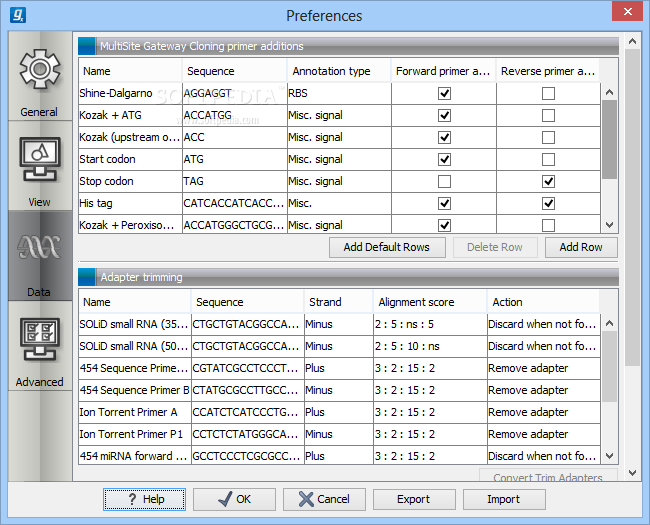

- #ASSEMBLY VIA CLC GENOMICS WORKBENCH FOR MAC OS#
- #ASSEMBLY VIA CLC GENOMICS WORKBENCH SOFTWARE#
- #ASSEMBLY VIA CLC GENOMICS WORKBENCH FREE#
There are 356 turtle species divided between two suborders. Turtles are a monophyletic group of reptiles recognized by their shell, a unique adaptation that makes them an iconic animal ( Lyson et al. The genome and genetic variants identified here provide a foundation for future studies of adaptation to climate. The quality and contiguity of the snapping turtle genome is similar to or better than most published reptile genomes.
#ASSEMBLY VIA CLC GENOMICS WORKBENCH SOFTWARE#
We assembled the transcriptome using RNA-Seq data and used gene prediction software to produce 22,812 models of protein coding genes. We identified 3.27 million SNPs in the reference turtle, which indicates a relatively high level of individual heterozygosity. BUSCO analysis revealed 97.4% of core vertebrate genes in the genome. The assembled genome was 2.258 Gb in size and had 13,224 scaffolds with an N50 of 5.59Mb. After trimming and filtering, we had 209.51Gb of Illumina reads, 25.72Gb of PacBio reads, and 21.72 Gb of Nanopore reads. We therefore established a captive breeding colony and sequenced DNA from one female using both short and long reads. They are also easy to maintain and breed in captivity and produce large clutch sizes, which makes them amenable to quantitative genetic and molecular genetic studies of traits like temperature-dependent sex determination. Common snapping turtles, Chelydra serpentina, are an ideal model species for studying adaptation to climate because they are widely distributed from tropical to northern temperate zones in North America. Yet, we have little understanding of the genetic adaptations that allow turtles to survive and reproduce in such diverse environments. ĬLC bio maintains a scientific focus by initializing and participating in various research projects around the world, including multiple projects funded by grants.Turtles are iconic reptiles that inhabit a range of ecosystems from oceans to deserts and climates from the tropics to northern temperate regions. 30% of the employees have a PhD and another 50% have a MSc. It is a profitable, privately owned company with 100 employees and has been acquired by Qiagen in late 2013.

CLC bio is no longer developing their own hardware-based products.ĬLC bio started commercial activities on Januheadquartered in Denmark. Hardware Įarly on, the company presented own-developed high-performance computing solutions, focusing on accelerating open source algorithms such as HMMER, Smith-Waterman and ClustalW, using FPGA technology.
#ASSEMBLY VIA CLC GENOMICS WORKBENCH FREE#
In 2020, CLC bio released a free plug-in that enables workflow execution on AWS directly from the CLC Genomics Workbench desktop software. In 2019, this platform was adapted for and approved for use in AWS GovCloud. In 2017, CLC bio launched their CLC Genomics Cloud Engine as a command-line driven platform for cloud-based bioinformatics workflow execution on Amazon Web Services. The platform includes both a desktop graphical user interface, command-line tools, a SOAP and REST API, and the ability to run containerized tools.ĬLC bio's analysis platform has been installed at several of the world's research institutions and at more than 2000 different organizations around the globe, including the top 10 pharmaceutical companies in the world.
#ASSEMBLY VIA CLC GENOMICS WORKBENCH FOR MAC OS#
CLC bio's software is platform independent and can be used for Mac OS X, Windows, and Linux. CLC bio also provides additional plugins (both free and commercial) that extend the platform for use in specific subject areas including genome finishing, microbial genomics, and structural biology.ĬLC bio's software allows the user to analyze, visualize, and compare genomic, transcriptomic, and epigenomic data from all major high-throughput sequencing platforms such as Illumina, Life Technologies, Roche 454, Pacific Biosciences, Oxford Nanopore, and Complete Genomics. Īmong other features, the software supports read mapping of Sanger and high-throughput sequencing data, de novo assembly of Sanger and high-throughput sequencing data, SNP detection on whole genomes of any size, detection of structural variations on whole genomes of any size, ChIP-seq analysis, RNA-Seq analysis, small RNA analysis and BLAST. In 2010, CLC bio was the first commercial platform for bioinformatics analysis that utilized a graphical user interface for building, managing, and deploying analysis workflows. While offering some open source algorithms with their tools, CLC bio have their own implementations of several popular applications, which have been accelerated using SIMD technology. CLC bio develops widely cited desktop, enterprise and cloud software for analysis of biological data.


 0 kommentar(er)
0 kommentar(er)
